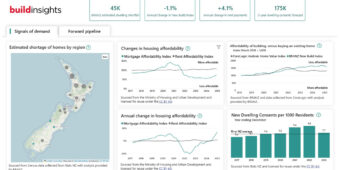MBIE releases product substitution guide for plasterboard
01 Aug 2022, Building and housing, Industry News, News

Due to the shortage of plasterboard products available in New Zealand, the Ministry of Business, Innovation and Employment (MBIE) has released a product substitution guide for plasterboard to enable progress for projects delayed due to a lack of the material
The purpose of the guidance is to help building consent authorities (BCAs), designers and contractors understand MBIE’s position “on the appropriate way to apply the Building (Minor Variation) Regulations 2009 with respect to the substitution of plasterboard wall and ceiling linings”.
MBIE added that the guidance is intended to promote clarity and certainty for everyone regarding minor variations involving plasterboard, as well as similar wall and ceiling linings.
In addition to that guidance, a Ministerial taskforce, comprising of the Minister for Building and Construction, key construction and supply chain experts, has been formed to investigate how plasterboard shortages can be eased.
Substitution of wall and ceiling lining elements with no specific performance requirements
MBIE guidance says that plasterboard substitution used for wall and/or ceiling linings, with no specific performance requirements, presents a low risk. Therefore, if a substitution is required, the minor variation process can be managed on site.
Designers and contractors who wish to substitute wall and ceiling lining plasterboard should follow these steps:
- Ensure the customer is informed about the substitution and agrees to it.
- Ensure the product chosen complies with the Building Code and make sure there is enough evidence that the BCA is satisfied it does.
- Ensure that you’re onsite to talk to the building control officer about the proposed substitution and can provide documentation if requested.
Substitution of plasterboard elements with specific performance requirements
If using plasterboard elements that have specific performance requirements, MBIE says that, in the majority of cases, a substitution should be processed as a minor variation rather than as an amendment to the building consent.
Designers and contractors who wish to substitute plasterboard elements with specific performance requirements as a variation should follow these steps:
- Ensure the customer is informed about the substitution and agrees to it.
- Ensure the product chosen complies with the Building Code and make sure there is enough evidence that the BCA is satisfied it does.
- If an application for a minor variation is needed, make sure to provide sufficient technical information, such as a product technical statement and installation specification, so the BCA can process the application as fast as possible.
- Keep in mind that it’s the designer’s responsibility to ensure work complies with Building Code (Section 14D of the Building Act).
“The BCA’s ability to process a substitution as a minor variation will depend to a large extent on the technical quality and credibility of the information provided by the designer or contractor,” stated MBIE.
“A failure to provide sufficient information will likely lead to delays in assessing variations, rejection of the application, or potentially the need to submit an application for an amendment to the building consent.”
It’s important to note that BCAs have been told not to accept substitution of wall or ceiling lining elements requiring specific performance properties unless there is sufficient evidence to enable the building consent official to be satisfied that work will company with Building Code.
Consideration of specific products
MBIE has provided guidance on two specific alternative products to GIB.
USG Boral products meet the following Building Code clauses:
- B1 Structure (B1.3.1, B1.3.2 and B1.3.4).
- B2 Durability (B2.3.1).
- F2 Hazardous Building Materials (F2.3.1) within the scope limitations of NZS3604:2011.
- USG Boral Partiwall has BRANZ appraisals for compliance with clause C3 Fire (C3.4 and C3.6) and clause G6 Airborne and impact sound (G6.3.1).
2) Elephant Board has a use history that may provide BCAs a level of confidence in the product as a bracing element substitution. BRANZ’s opinion is that Elephant Board meets Building Code if installed as described in the technical literature.
Technical information on specialist products
MBIE says that it is aware of other wall and ceiling linings products available in New Zealand and has attached technical information provided by the suppliers that outlines product testing specification, test results and appraisals to the guidance.
It can be viewed via this link, by scrolling all the way to the bottom.
It’s worthwhile to check the list from time to time, as MBIE intends to update it with additional products when it becomes aware of them.
Register to earn LBP Points Sign in



